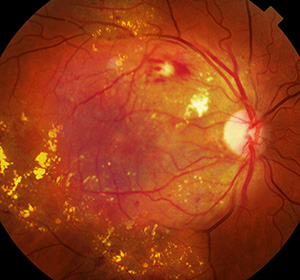
Introduction
Proliferative diabetic retinopathy (PDR) is an advanced stage of diabetic retinopathy, a complication of diabetes that damages the retina’s blood vessels. In PDR, abnormal new blood vessels grow on the retina and optic nerve in response to poor oxygen supply. These fragile vessels can bleed, causing vision disturbances and potentially leading to severe complications such as retinal detachment or neovascular glaucoma. Early detection and treatment are crucial to managing PDR, preserving vision, and preventing permanent damage.
Causes and Risk Factors of Proliferative Diabetic Retinopathy
What Causes Proliferative Diabetic Retinopathy (PDR)?
Proliferative diabetic retinopathy develops as a result of prolonged high blood sugar levels damaging the small blood vessels in the retina. This damage leads to poor oxygen supply, prompting the growth of fragile new blood vessels that can bleed or cause scarring. Understanding the causes and risk factors helps in early detection and management.
Common causes and risk factors include:
- Diabetes Duration and Control
The longer a person has diabetes, especially if blood sugar levels are poorly controlled, the higher the risk of PDR. - High Blood Pressure
Hypertension can worsen retinal blood vessel damage. - Kidney Disease
Diabetic nephropathy is linked with more severe retinopathy. - Pregnancy
Hormonal changes can accelerate progression in some cases. - Smoking
Smoking contributes to vascular damage and worsens outcomes. - Genetic Predisposition
Family history of diabetic retinopathy increases risk. - Previous Eye Conditions
Existing retinal damage or macular edema raises the likelihood of PDR development.
Awareness of these factors encourages regular eye check-ups and early intervention to protect vision.
Types of Proliferative Diabetic Retinopathy (PDR)
The Different Types of PDR
Proliferative diabetic retinopathy varies depending on the extent of abnormal blood vessel growth and associated complications. Identifying the type is crucial for treatment planning and prognosis.
Early Proliferative Diabetic Retinopathy
- Description:
Initial stage marked by the formation of new, abnormal blood vessels (neovascularization) near the retina or optic nerve, without significant bleeding. - Who it affects:
Patients with moderate diabetic retinopathy developing early neovascular changes. - Speed of progression:
May progress slowly but can worsen without treatment.
High-Risk Proliferative Diabetic Retinopathy
- Description:
Advanced neovascularization with an increased risk of vitreous hemorrhage and retinal detachment. - Who it affects:
Patients with poor diabetic control or delayed treatment. - Speed of progression:
Often rapid progression requiring urgent intervention.
Advanced Proliferative Diabetic Retinopathy
- Description:
Extensive neovascularization with fibrous scar tissue formation leading to tractional retinal detachment and significant vision loss. - Who it affects:
Patients with long-standing untreated PDR or complications. - Speed of progression:
Typically rapid and sight-threatening.
Each type requires specific management strategies to prevent vision loss and address complications.
Early Signs & Symptoms
Common Symptoms of Proliferative Diabetic Retinopathy (PDR)
Recognising early symptoms of PDR is vital for timely intervention to prevent severe vision loss. Symptoms may develop gradually or suddenly, so prompt eye examinations are crucial.
- Floaters or spots in vision
Small dark spots or cobweb-like shapes drifting across your field of vision caused by bleeding from abnormal blood vessels.
- Blurred or distorted vision
Vision may become unclear or warped due to swelling or retinal damage.
- Sudden vision loss or shadows
May indicate vitreous hemorrhage or retinal detachment and requires urgent evaluation.
- Difficulty seeing at night
Reduced night vision or increased glare from lights.
- Decreased color perception
Colours may appear faded or less vibrant.
Early detection of these symptoms allows for faster treatment to preserve vision and avoid complications.
Diagnosis and Treatment of Proliferative Diabetic Retinopathy
Proliferative diabetic retinopathy (PDR) is diagnosed through a thorough eye examination including dilated fundoscopy to visualize the retina and detect abnormal blood vessels. Advanced imaging tests like fluorescein angiography and optical coherence tomography (OCT) help assess the extent of neovascularization and retinal damage. Early detection through regular screening is crucial for timely intervention. Treatment options for PDR include laser photocoagulation to seal leaking vessels, anti-VEGF injections to reduce abnormal vessel growth, and vitrectomy surgery for severe cases involving vitreous haemorrhage or retinal detachment. Prompt treatment can slow disease progression, preserve vision, and reduce the risk of complications.
Why Timely Diagnosis Matters
Early diagnosis of proliferative diabetic retinopathy (PDR) is vital to prevent vision-threatening complications such as vitreous haemorrhage and retinal detachment. Detecting PDR before symptoms become severe allows for timely treatment, which can slow or stop disease progression and preserve sight.
Timely diagnosis enables your ophthalmologist to:
- Identify abnormal new blood vessel growth early
- Monitor disease progression and adjust treatment plans promptly
- Prevent severe bleeding and retinal detachment through laser or injection therapies
- Reduce the risk of permanent vision loss by intervening before complications arise
- Educate patients on managing diabetes and eye health for long-term preservation of vision
Addressing PDR early improves treatment success and helps maintain the best possible vision and quality of life.
Continue Learning About Other Eye Conditions
Other Eye Conditions
The eyes are the most complex sensory organ in our bodies. The eyes provide vision by recording images of our surroundings that the brain will interpret. Although the eye measures only about an inch...
Macular Hole
A macular hole is a defect in the macula, the central part of the retina (light receptive tissue of the eye). The macula is responsible for the sharp central vision required for reading, driving, etc.
Worried About Your Vision?
Schedule a consultation with Mr. Mo Majid to evaluate your eye health.
Quick Answers About Proliferative Diabetic Retinopathy
What causes proliferative diabetic retinopathy?
It develops due to prolonged high blood sugar levels damaging retinal blood vessels, leading to abnormal new vessel growth.
Can PDR cause sudden vision loss?
Yes, bleeding into the eye or retinal detachment from scar tissue can cause rapid vision loss.
How often should I have my eyes checked if I have diabetes?
Annual comprehensive eye exams are recommended, or more frequently if you have diabetic retinopathy.
Can controlling blood sugar prevent PDR?
Good diabetes management significantly reduces the risk of developing or worsening PDR.







